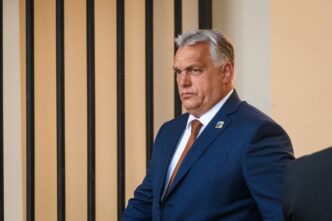In a whirlwind week of international diplomacy, US President Donald Trump has demonstrated a notable shift in his foreign policy approach, engaging in a series of high-stakes negotiations and decisions that have left global observers assessing his strategic objectives. Trump’s recent actions hint at a broader agenda that extends beyond his customary “America First” rhetoric, suggesting a more complex vision for global engagement.
Throughout the week, President Trump and his administration have made significant diplomatic moves across multiple regions. In the Gulf, Trump secured substantial business deals, reportedly amounting to $600 billion in investments into the United States. This aligns with his vision of fostering international relations through trade rather than conflict, emphasizing commerce over chaos.

Additionally, Trump’s administration made pivotal decisions such as lifting sanctions on Syria, negotiating the release of an American citizen from Hamas, and ceasing military strikes on Houthi fighters in Yemen. These actions reflect a preference for direct engagement rather than prolonged military interventions, a notable departure from past US foreign policy strategies.
In negotiations with China, the administration reduced tariffs, marking a significant de-escalation in trade tensions. This move, alongside continued discreet talks with Iran regarding nuclear capabilities, underscores a willingness to engage in pragmatic diplomacy.
A particularly bold step involved Trump’s directive for Ukraine to engage in talks with Russia in Turkey, a move that surprised many and deviated from the previously coordinated strategy with European allies. The US’s claimed role in brokering a ceasefire between India and Pakistan further illustrates Trump’s hands-on approach to international conflicts.
Trump’s recent visit to the Middle East highlighted his strategy of leveraging economic agreements to foster peace, yet his absence from Israel during this tour and his independent actions regarding Syria and Yemen have raised questions regarding US-Israeli relations. This approach, coupled with the administration’s ongoing negotiations with Iran, suggests a nuanced shift in the US’s traditional alliances in the region.
Critics and diplomats have expressed concerns about the impulsive nature of some decisions, often made with limited internal consultation. Trump’s fluctuating positions, particularly on issues like the war in Ukraine, have led to confusion among international stakeholders about the consistency of US policy.
Despite the frenetic pace of diplomatic activity, the fundamental challenges in regions like Gaza and Ukraine remain unresolved. The ambitious goal of normalizing relations between Israel and Saudi Arabia remains distant, and market instability continues despite tariff reductions.
Ultimately, Trump’s actions reveal a global ideology that is not isolationist but rather mercantilist, with a focus on economic partnerships as a means to achieve peace. However, the effectiveness and sustainability of this strategy in resolving complex geopolitical conflicts remain to be seen.








